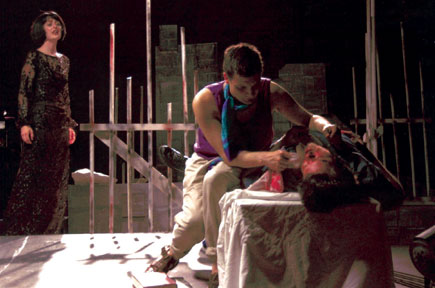Introduction to Latin American fiction
by Madeleine WIGHTMAN
Part 3
I mentioned in Parts 1 and 2 of this article how post-boom
contemporary authors preferred to set their novels against the backdrop
and in the context of contemporary society and popularised political
writing and we have looked at Allende’s work as an example of this.
I will now examine a couple of films that I have already mentioned
and that you may already be familiar with. These started out as
post-boom novels but were later made into films, making their political
and social message accessible to the masses.
Manuel Puig's 'The Kiss of the Spider Woman', which was published in
Spanish and English in 1976, was made into a film in 1985. It has
previously been described by critics as a classic show-piece to
demonstrate the 'new novel’.
Puig himself said "The book is very much about the Argentina of 1973.
There was ideological repression and social repression. I wanted to put
those things together. The rightist government was suspicious of any
leftist ideology and the leftists were puritanical in the sexual area.
 |
|
A scene from the movie |
The repression was expressed in different ways. What I mainly wanted
to talk about was the possibility of people changing."Stylistically it
clearly demonstrates the advantages of new genres over the old-style
traditional realism.
The Kiss of the Spider Woman
Two prisoners, Luis and Valentín share a cell in a Buenos Aires
Prison. Molina, an effeminate and openly homosexual window-dresser, is
in jail for "corruption of a minor," while Valentín is a political
prisoner who is part of a revolutionary group trying to overthrow the
government. Molina recounts five films that he has seen to Valentin in
order for them both to forget their situation.
Puig uses intertextuality (telling a story within a story) to
introduce the political theme of authority and power which is intrinsic
to the novel. Molina's way of telling film narratives are authoritarian
and repressive as they force their own point of view upon the reader.
However, the novel itself as a whole frees the reader to form his or her
own interpretation.
The novel's form is unusual in that there is no traditional narrative
voice, one of the primary features of fiction. It is written in large
part as dialogue, without any indication of who is speaking, except for
a dash (-) to show a change of speaker. The novel is mainly written as a
stream of consciousness and what is not written in this way or as a
dialogue is written as government documentation.
The conversations that the characters engage in, when not focused on
the moment at hand are focused on films that Molina has seen, which act
as a form of escape from their environment. There is therefore a main
plot with five subplots.
These subplots are films presented as mini stories which comprise
much of the novel. The author includes a long series of footnotes on the
psychoanalytic theory of homosexuality. These act largely as a mini
representation of Puig's political intention in bringing about a more
objective view of homosexuality.
Valentin, the Marxist protagonist, has risked his life and willingly
endured torture for a political cause and his example helps transform
his cell-mate into a citizen and as someone who will eventually re-enter
society.
Molina's love of aesthetics and cultural life teaches Valentin that
escapism can have a powerfully Utopian purpose in life and that escapism
has the potential to be just as subversive and meaningful as political
activity.
In the middle of the novel the reader discovers that Molina is
actually a spy that is sent to Valentin's jail to befriend him and try
to extract information about his organization. Molina gets provisions
from the outside for his cooperation with the officials which he shares
with Valentin.
It is through his acts of kindness to Valentin that the two fall into
a romance and briefly become lovers. The emotional and sexual union of
the two men signifies in a very real way Puig's belief that in order to
be effective, politics should relate to real life and not be purely
theoretical. The notion spider woman being trapped in her own web seems
to symbolise that we are all trapped in our own realities.
'The kiss' signifies liberation from this trap in that we can freely
dwell in reality and fantasies providing a bridge between the two and
ultimately provide meaning. The 1985 film version is a very example of
post-Boom popular fiction during a time where the issues it presented
were very sensitive to the public, giving it a high degree of popularity
at the time it was screened.
'The Kiss of the Spiderwoman' then is an excellent example of
post-Boom fiction, since it breaks with traditional narrative styles and
experiments with new ways of telling a story. It employs some of the
techniques used by Boom, such as magical realism, or in this case, the
stream of consciousness and the recounting of stories within the story.
However, the novel and the film have a very explicit political
message within contemporary society, made accessible and popular for the
masses by the 'new narrative' styles.
Like Water for Chocolate
The other example is Laura Esquivel’s 1989 novel ‘Like water for
Chocolate’ which was subsequently made into a film in 1992. The English
translation of the novel 'Like water for chocolate' and sub-titled film
were equally successful in the United States and the film was the
largest grossing foreign film ever up to that point.
The novel follows the story of a young girl named Tita who longs her
entire life to marry her lover, Pedro, but can never have him because of
her mother's upholding of the family tradition of the youngest daughter
not marrying but taking care of her mother until the day she dies.
Tita is only able to express herself when she cooks. Esquivel’s novel
falls very much into the post-Boom, yet she traded on the success of the
use of Magical Realism associated with the Boom.
Here the magical realist episodes are intrinsic to the development of
the story, which is at the same time rooted in real Mexican society in
1910 and takes the viewer through the Mexican revolution right up to
1938.
The narrator is Tita's great-niece and the story is set in northern
Mexico. The novel's 12 chapters, written one per month in
diary/instalment form relate details from over two decades of Tita's
life, beginning in 1910 when she is fifteen years old and ending with
her death at thirty-nine. Each chapter includes a recipe that Tita
prepares for her family during this period.
The story begins with Tita’s mother’s refusal to allow her to marry
Pedro, the man she loves. Mama Elena offers Pedro Rosaura's hand instead
since she is the eldest daughter.
To the dismay of his father, Pedro accepts simply to be closer to
Tita. When Tita finds an excuse to not attend Rosaura's engagement
party, Mama Elena forces Tita to prepare the wedding banquet as
punishment.
Yet Tita puts all her desire for Pedro into the cooking and as the
wedding guests eat the cake, they are overcome by an "intoxication"
which causes intense longing for their true love. Tita perpetually
channels her frustrated desires into the creation of delicious meals
that often have strange, magical effects on her family.
 |
|
A scene from the movie |
The novel is typical of the post-Boom genre of writing, as the
magical realist episodes are intrinsic to the development of the story,
which is at the same time rooted in real Mexican society in 1910 where
the story begins.
Magical realism is also used to provoke a sense of national identity
through popular culture by the use of Tita's mestizo cooking and the
physical reactions of those who consume her food.
Her violent attacks and ultimate revenge on Rosaura, who eventually
dies of 'serious digestive problems' following a spate of particularly
vicious, jealous rows between the sisters. Gertrudis, Tita's other
sister, elopes with a soldier involved in the Revolution, which
symbolises a desire for change in both domestic and political spheres.
When a rose given to her secretly by Pedro, Tita uses it to vent her
unexpressed passion through a pre-Hispanic recipe - 'Quail in Rose Petal
Sauce'.
Feminine representation
All the female characters in 'Like Water for Chocolate' are battling
for liberation in one way or other. This also includes Tita's tyrannical
mother Doña Elena, who herself represents both the oppressive
patriarchal system and the traditions which incarcerate Tita.
However, it transpires that Doña Elena was also frustrated by a
loveless marriage to Tita's father and that Gertrudis is the result of
an affair with a 'Mulatto' (indigenous Latin American man) While on the
surface 'Like Water for Chocolate' appears to be a progressive narrative
that celebrates women's willingness to break from tradition, a closer
reading reveals that real change is stifled.
Feminine power is derived from the preparation of food and through
fulfilling other traditional roles such as marriage and motherhood but
it is essentially the masculine gaze and agency which determine the
course of the novel. Pedro's decision to marry Rosaura and the
implication that Tita will only find liberation and redemption through
marriage after Mama Elena's death are examples of this.
There is no possibility for Tita to define herself outside
traditional feminine roles. In creating the female-centered cast of
characters, Esquivel creates a world in which although men are
physically present only occasionally, the legacy of sexism and the
confinement of women to the domestic sphere persist.
Esquivel does not offer her readers the vision of Utopian sisterhood
but an insight into the way women are restricted by standards of
societal propriety perpetuated by other women. Although a medium for
self-expression, the culinary 'mestizo' culture that represents both
femininity and Mexican national identity, it still occurs within the
context of traditional, patriarchal structures.
This suggests that for woman and for Mexican society itself, which
has an identity so deeply rooted in tradition, true liberation is an
illusory ideal, yet one well worth striving for.
Conclusion
To conclude, despite the radical nature of both form and content of
the boom and post boom phases of Latin American literature, we are
finally left with an uneasy perception that the patriarchal system
continues to impose limits on the revolutionary aspirations of the
movement’s authors and readers.
The only way that these aspirations can find expression is within in
a magical dimension, which is separate from the concrete constriction of
day to day life.
They are perhaps unattainable ideals beyond the confines of practical
experience, whose beauty entices and enchants.
Yet maybe the genuine assimilation of pre-Columbian traditions with
modern life within a society which serves the indigenous, mestizo (or
Latino) inhabitants of Latin America in a fair and equitable way will
continue to be a work in progress, always a little out of reach.
|

